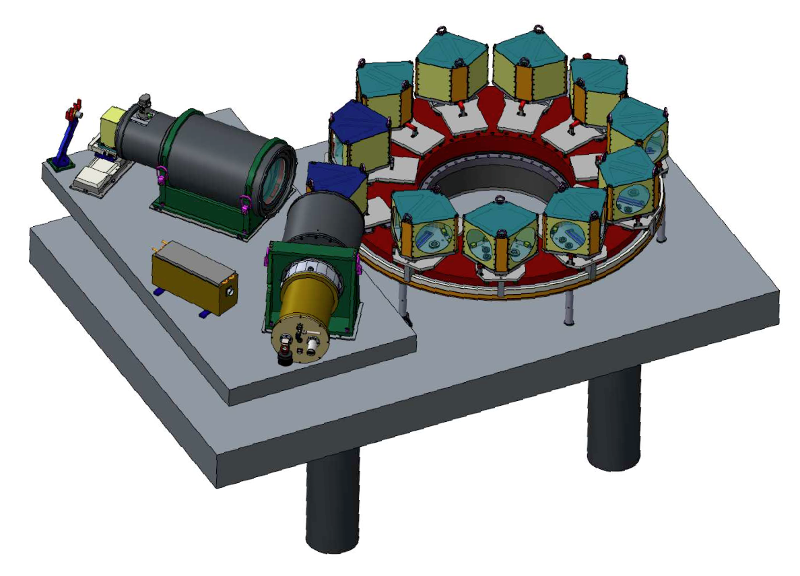Instrument: Spectrograph
The MEGARA spectrograph will be located on GTC Nasmyth A platform while the optical fiber bundles will be routed from the Folded Cassegrain F focus to the entrance of the spectrograph at the pseudo-slit position. MEGARA has a fully refractive optical system. The spectrograph is composed by a pseudo-slit, where the fibers are placed simulating a long slit 119 mm length and with a RoC of 1075 mm. Then the light passes through the collimator, which is composed by 5 lenses and has a focal length of 483 mm, and a slit shutter placed behind the first collimator lens. The geometry is fixed for all spectral resolution modes and it is 68 degrees between collimator and camera. The pupil has 160 mm diameter and it is the location for the VPH-gratings (see figure below).

The spectrograph subsystems include the pseudo-slit, with a XY mechanism that allows (1) exchanging among the three positions (LCB, MOS, OPEN) and (2) moving towards and away the first lens of the collimator for focusing; the shutter; the cryostat, the pupil elements at their mechanism, and the camera, which is joined to the cryostat through the last lens, through the last lens, with the CCD detector inside. The cryostat is based on liquid nitrogen. The detector is a deep-depleted Silicon 4k x 4k E2V CCD231-84 15μm pixels and 4 outputs with astro-2 coating. The CCD is < 3e- read noise and has excellent QE across almost the whole visible spectrum. In order to minimize electronic cross-talk between amplifiers we will read using two diagonally-opposed amplifiers.
The MEGARA spectrograph provides three ranges of spectral resolution: low (LR), medium (MR) and high (HR), with excellent transmission thanks to the use of VPHs. The MEGARA VPHs characteristics are summarized in the Table below.
| VPH Name | Set-up | R (FWHM) |
λ1 - λ2 (Å) |
λc (Å) |
Δλ (@ λc) (Å) |
Δv (km/s) |
lin res Å/pix |
|
| 1 | VPH405-LR | LR-U | 6028 | 3653 - 4386 | 4051 | 0.672 | 50 | 0.17 |
| 2 | VPH480-LR | LR-B | 6059 | 4332 – 5196 | 4800 | 0.792 | 49 | 0.20 |
| 3 | VPH570-LR | LR-V | 6080 | 5143 – 6164 | 5695 | 0.937 | 49 | 0.23 |
| 4 | VPH675-LR | LR-R | 6099 | 6094 – 7300 | 6747 | 1.106 | 49 | 0.28 |
| 5 | VPH799-LR | LR-I | 6110 | 7220 – 8646 | 7991 | 1.308 | 49 | 0.33 |
| 6 | VPH890-LR | LR-Z | 6117 | 8043 - 9630 | 8900 | 1.455 | 49 | 0.36 |
| 7 | VPH410-MR | MR-U | 12602 | 3917 - 4277 | 4104 | 0.326 | 24 | 0.08 |
| 8 | VPH443-MR | MR-UB | 12370 | 4225 – 4621 | 4431 | 0.358 | 24 | 0.09 |
| 9 | VPH481-MR | MR-B | 12178 | 4586 – 5024 | 4814 | 0.395 | 25 | 0.10 |
| 10 | VPH521-MR | MR-G | 12035 | 4963 – 5443 | 5213 | 0.433 | 25 | 0.11 |
| 11 | VPH567-MR | MR-V | 11916 | 5393 - 5919 | 5667 | 0.476 | 25 | 0.11 |
| 12 | VPH617-MR | MR-VR | 11825 | 5869 - 6447 | 6170 | 0.522 | 25 | 0.13 |
| 13 | VPH656-MR | MR-R | 11768 | 6241 - 6859 | 6563 | 0.558 | 25 | 0.14 |
| 14 | VPH712-MR | MR-RI | 11707 | 6764 - 7437 | 7115 | 0.608 | 26 | 0.15 |
| 15 | VPH777-MR | MR-I | 11654 | 7382 - 8120 | 7767 | 0.666 | 26 | 0.17 |
| 16 | VPH926-MR | MR-Z | 11638 | 8800 - 9686 | 9262 | 0.796 | 26 | 0.20 |
| 17 | VPH665-HR | HR-R | 18700 | 6445 - 6837 | 6646 | 0.355 | 16 | 0.09 |
| 18 | VPH863-HR | HR-I | 18701 | 8372 - 8882 | 8634 | 0.462 | 16 | 0.12 |
The wavelength coverage and spectral resolutions achieved by each VPH in the LCB and MOS modes is summarized in the figure below.

In order to accommodate and exchange the gratings, the MEGARA spectrograph has a Pupil Mechanism composed by the VPH wheel and a insertion mechanism. The wheel can host 11 VPHs mounted simultaneously. The mechanical mount of each VPH is screwed to a platform.
The figure below shows the 3D of the MEGARA spectrograph.


